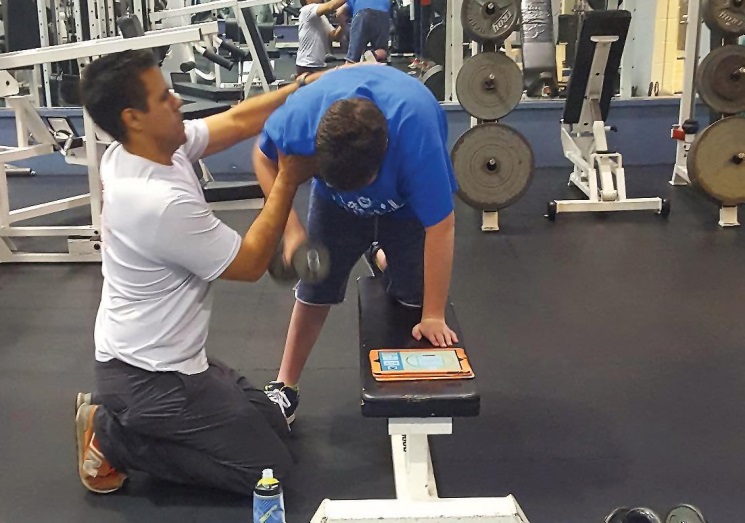
WORTH THE WEIGHT: Coach Dave guides Brody to maximize his lifting exercises. Weight training can tone muscle, improve posture, reduce tension in the neck and shoulders, and calm the nervous system.
SEE THE DIFFERENCE – VISUALS WORK!
When talking with parents to learn about their children, I always ask "does your son/daughter use visuals?" A common response from many parents is, "No, my child can talk." I understand that some parents may confuse visuals, or visual supports, with PECS (Picture Exchange Communication System) which is commonly used with individuals who are nonverbal or have limited communication. When asking this question, I am not referring to just PECS.
Successfully engaging a person with autism in any new activity - especially exercise - will take patience, creativity, and the use of evidence-based teaching practices (EBPs). One effective method to teach those with autism are visual supports (e.g., photos, visual schedules, video models, social narratives, modeling). Visual supports add structure, routine, and sequence that many children with autism require to carry out their daily activities.10 When implemented correctly, visual supports allow students with autism the freedom to engage in life, regardless of impairment.6
Visual supports and other evidencebased practices (e.g., technology-aided instruction, reinforcement, and peer-mediated instruction) are successfully used in
special education classrooms to teach academic and functional skills. When you use these same strategies to teach exercise, they will be familiar and effective.
When I first began teaching exercise, there were limited paper-based exercise visuals (e.g., jumping jacks, walk or run) or sport visuals. The ones that did exist fell short of communicating effectively to my students. For example, when the objective was to have my students kick a soccer ball to each other, the best visual I could find showed half a leg touching a soccer ball. Anyone who understands autism knows that they need the whole picture. I quickly realized there was a need for exercise visuals that would successfully communicate instruction and empower individuals to reach their full potential.
To best help the individuals, and the professionals or parents teaching them, I brought together a multidisciplinary team of professionals (i.e., special education teachers, physical therapist, and speechlanguage pathologist). Together, we built a variety of high-quality, inclusive visual systems. The paper-based Visual Exercise System allows parents and professionals to create visual, structured, and functional exercise sessions for individual & group programs, yoga, sports, and many other activities. These color-coded systems bring a consistency that the children and students are familiar with and provides images
EXERCISE SUCCESS | 3 STEPS
1. USE PICTURES
Many with ASD, if not most, benefit from visual supports. They can be especially helpful when you start incorporating exercise (or any new task) into your child's routine. The pictures teach and show them what is expected.
2. ESTABLISH STRUCTURE
Creating structure and routine can be a powerful reinforcement for autistic individuals. Develop structure by staying consistent with exercises, scheduling, and timing. Visual supports will also help to establish structure. Pick a day, a time, and get started. You may begin once a week and then gradually increase to two-to-three times per week as you discover what works best for your child.
3. APPLY IN CROSS CURRICULUM
Exercise is a lifestyle change or a lifestyle addition. Educate and share the research and many benefits with your child's teachers and therapists. Exercise should not be limited to only physical education; it can be used a sensory break as well.
THERE'S AN APP FOR THAT: Supported in seven research studies, Exercise Buddy leverages technology to empower those with autism and other disabilities to exercise at home, in the gym, or in the classroom.